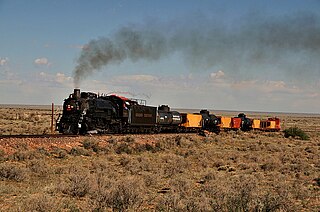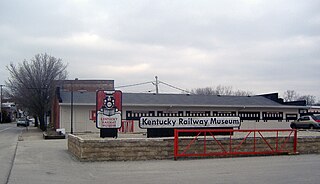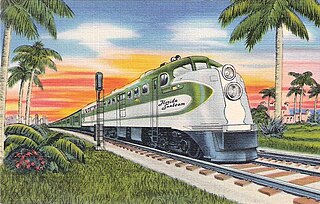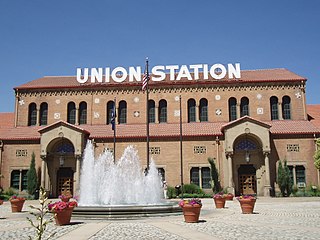
The National Railway Museum (NRM) is a museum in York, England, forming part of the Science Museum Group. The museum tells the story of rail transport in Britain and its impact on society. It is the home of the national collection of historically significant railway vehicles such as Mallard, Stirling Single, Duchess of Hamilton and a Japanese bullet train. In addition, the National Railway Museum holds a diverse collection of other objects, from a household recipe book used in George Stephenson's house to film showing a "never-stop railway" developed for the British Empire Exhibition. It has won many awards, including the European Museum of the Year Award in 2001.

The American Locomotive Company was an American manufacturer that operated from 1901 to 1969, initially specializing in the production of locomotives but later diversifying and fabricating at various times diesel generators, automobiles, steel, tanks, munitions, oil-production equipment, as well as heat exchangers for nuclear power plants.

The Nene Valley Railway (NVR) is a preserved railway in Cambridgeshire, England, running between Peterborough Nene Valley and Yarwell Junction. The line is 7+1⁄2 miles (12.1 km) in length. There are stations at each terminus, and three stops en route: Orton Mere, Ferry Meadows and Wansford.

The GE U25B is General Electric's first independent entry into the United States domestic road switcher diesel-electric locomotive railroad market for heavy production road locomotives since 1936. From 1940 through 1953, GE participated in a design, production, and marketing consortium (Alco-GE) for diesel-electric locomotives with the American Locomotive Company. In 1956 the GE Universal Series of diesel locomotives was founded for the export market. The U25B was the first attempt at the domestic market since its termination of the consortium agreement with Alco.

The California State Railroad Museum is a museum in the California State Parks system that interprets the role of railroads in the West. It is located in Old Sacramento State Historic Park at 111 I Street, Sacramento, California.
The Cartier Railway is a privately owned railway that operates 260 miles (418 km) of track in the Canadian province of Québec.

The ALCO HH series was an early set of diesel switcher locomotives built by the American Locomotive Company (ALCO) of Schenectady, New York between 1931 and 1940, when they were replaced by the S series: the 660 hp (490 kW) S-1 and 1,000 hp (750 kW) S-2. They were ALCO's first diesel switchers to enter true series production, and among the first land vehicles anywhere to use the revolutionary diesel-electric power transmission.

The Grand Canyon Railway is a heritage railroad which carries passengers between Williams, Arizona, and the South Rim of Grand Canyon National Park.

The ALCO RS-1 was a 4-axle diesel-electric locomotive built by Alco-GE between 1941 and 1953 and the American Locomotive Company from 1953 to 1960. ALCO subsidiary Montreal Locomotive Works built an additional three RS-1s in 1954. This model has the distinction of having the longest production run of any diesel locomotive for the North American market. The RS-1 was in production for 19 years from the first unit Rock Island #748 in March 1941 to the last unit National of Mexico #5663 in March 1960.

The Kentucky Railway Museum, now located in New Haven, Kentucky, United States, is a non-profit railroad museum dedicated to educating the public regarding the history and heritage of Kentucky's railroads and the people who built them. Originally created in 1954 in Louisville, Kentucky, the museum is at its third location, in extreme southern Nelson County. It is one of the oldest railroad stations in the United States.

Richmond Locomotive Works was a steam locomotive manufacturing firm located in Richmond, Virginia.

The ALCO DL-109 was one of six models of A1A-A1A diesel locomotives built to haul passenger trains by the American Locomotive Company (ALCO) between December, 1939 and April, 1945. They were of a cab unit design, and both cab-equipped lead A units DL-103b, DL-105, DL-107, DL-109 and cabless booster B units DL-108, DL-110 models were built. The units were styled by noted industrial designer Otto Kuhler, who incorporated into his characteristic cab the trademark three-piece windshield design. A total of 74 cab units and four cabless booster units were built.

Otto August Kuhler was an American designer, one of the best known industrial designers of the American railroads. According to Trains magazine he streamstyled more locomotives and railroad cars than Cret, Dreyfuss and Loewy combined. His extensive concepts for the modernization of the American railroads have repercussions onto the railways worldwide until today. In addition he was a prolific artist of industrial aesthetics and of the American West in general.

The ALCO FA was a family of B-B diesel locomotives designed to haul freight trains. The locomotives were built by a partnership of ALCO and General Electric in Schenectady, New York, between January 1946 and May 1959. Designed by General Electric's Ray Patten, they were of a cab unit design; both cab-equipped lead FA and cabless booster FB models were built. A dual passenger-freight version, the FPA/FPB, was also offered. It was equipped with a steam generator for heating passenger cars.

Union Station, also known as Ogden Union Station, is a train station in Ogden, Utah, United States, at the west end of Historic 25th Street, just south of the Ogden Central Station. Formerly the junction of the Union Pacific(UP) and Central Pacific (CP) railroads, its name reflects the common appellation of train stations whose tracks and facilities are shared by railway companies.
The Heart of Dixie Railroad Museum is the official state railroad museum of Alabama. Dedicated to the preservation, restoration, and operation of historically significant railway equipment, the museum is located at 1919 Ninth Street, Calera, Alabama, on I-65 approximately 30 miles (48 km) south of Birmingham.

The Slovenian Railway Museum, or Railway Museum of Slovenian railways, in Ljubljana, Slovenia, located on Parmova ulica 35, is the national museum for Slovenia's railway history.

The North Alabama Railroad Museum, Inc. is a railroad museum in Huntsville, Alabama. The museum, incorporated in 1966, is an all volunteer organization. The museum has a collection of rolling stock, a small train station, and a small heritage railroad called the Mercury and Chase Railroad which operates between April and December. The mission of the NARM is to "preserve railroad history in North Alabama and South Central Tennessee." It is run entirely by its 100-plus volunteers. The museum is open to the public daily, volunteers are usually available on Wednesdays and Saturdays. Admission to the museum is free, however there is a charge for riding the trains. A schedule of rides is available at the museum's website.

The Russian locomotive class Ye, and subclasses Yea, Yek, Yel, Yef, Yem, Yemv and Yes were a series of 2-10-0 locomotives built by American builders for the Russian railways in World War I and again in World War II. They were lightweight engines with relatively low axle loadings.

S-Motor was the class designation given by the New York Central to its ALCO-GE built S-1, S-2, S-2a and S-3 electric locomotives. The S-Motors hold the distinction of being the world's first mass-produced main line electric locomotives with the prototype #6000 being constructed in 1904. The S-Motors would serve alone until the more powerful T-motors began to arrive in 1913, eventually displacing them from main line passenger duties. From that point the class was assigned to shorter commuter trains and deadhead rolling stock between Grand Central Terminal and Mott Haven coach yard. Some examples, including the prototype later renumbered #100, would serve in this capacity through the Penn Central merger in 1968, only being retired in the 1970s as long distance passenger traffic to Grand Central dried up.




















